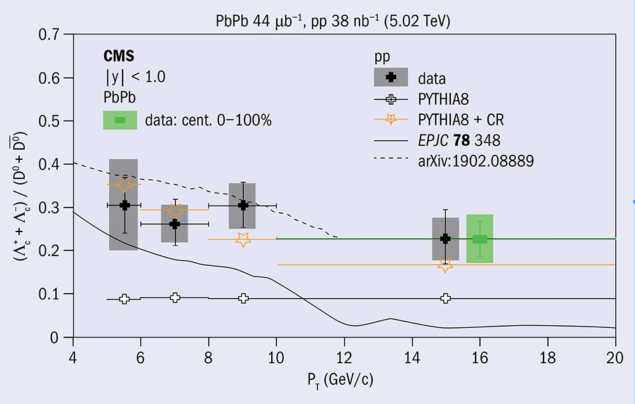
One of the most useful ways to understand the properties of the quark–gluon plasma (QGP) formed in relativistic heavy-ion collisions is to study how various probes interact when propagating though it. Heavier quarks, such as charm, can provide unique insights as they are produced early in the collisions, and their interactions with the QGP differ from their lighter cousins. One important input to these studies is a detailed understanding of hadronisation, by which quarks form experimentally detectable mesons and baryons.
The lightest charm baryon and meson are the Λ+c (udc) and the D0 (cu̅). In proton– proton (pp) collisions, charm hadrons are formed by fragmentation, in which charm quarks and antiquarks move away from each other and combine with newly generated quarks. In heavy-ion collisions, hadron production can also occur via “coalescence”, whereby charm quarks combine with other quarks while traversing the QGP. The contribution of coalescence depends strongly on the transverse momentum (pT) of the hadrons, and is expected to be much more significant for charm baryons than for charm mesons, as they contain more quarks.
The CMS experiment has recently determined the Λ+c/D0 yield ratio over a broad range of pT using the Λ+c → pK–π+ and D0 → K–π+ decay channels in both pp and lead–lead (PbPb) collisions, at a nucleon–nucleon centre-of-mass energy of 5.02 TeV. Comparing the behaviour of the Λ+c/D0 ratio in different collision systems allows physicists to study the relative contributions of fragmentation and coalescence.
The measured Λ+c/D0-production cross-section ratio in pp-collisions (figure 1) is found to be significantly larger than that calculated in the standard version of the popular Monte-Carlo event generator PYTHIA, while the inclusion of an improved description of the fragmentation (“PYTHIA8+CR”) can better describe the CMS data. The data can also be reasonably described by a different model that includes Λ+c baryons produced by the decays of excited charm baryons (dashed line). However, an attempt to incorporate the coalescence process characteristic of hadron production in heavy-ion collisions (solid line) fails to reproduce the pp-collision measurements.
The CMS collaboration also measured Λ+c production in PbPb collisions. The Λ+c/D0-production ratio for pT > 10 GeV/c is found to be consistent with that from pp collisions. This similarity suggests that the coalescence process does not contribute significantly to charm hadron production in this pT range for PbPb collisions. These are the first measurements of the ratios at high pT for both the pp and PbPb systems at a nucleon–nucleon centre-of-mass energy of 5.02 TeV.
In late 2018, CMS collected data corresponding to about 10 times more PbPb collisions than were used in the current measurement. These will shed new light on the interplay between the different processes in charm–quark hadronisation in heavy-ion collisions. In the meantime, the current results highlight the lack of understanding of charm–quark hadronisation in pp collisions, a subject that requires further experimental measurements and theoretical studies.
Further reading
CMS Collaboration 2019 arXiv:1906.03322.





